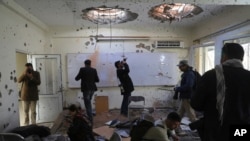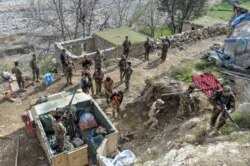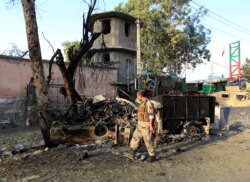The Islamic State’s affiliate in Afghanistan – seemingly pushed to the brink last year following unrelenting pressure from the U.S. and Afghan militaries, and by multiple Taliban offenses – appears to have recovered and may soon look to strike further afield, according to U.S. military and intelligence officials.
The turnaround for IS-Khorasan, as the group’s Afghan affiliate is known, contrasts with its waning fortunes just over a year ago, when U.S. officials estimated it had lost “up to half its force” while suffering a string of defeats in Nangarhar and Kunar provinces.
Stripped of its key territories, U.S. intelligence estimates at the time suggested IS-Khorasan was down to as few as 1,000 fighters. So too, there were growing questions about its offensive capabilities.
But more recent intelligence suggests the bleeding has, at least stopped.
“New leadership allowed it to stabilize and increase localized and lone wolf attacks throughout the second half of the year [2020],” U.S. Central Command Gen. Kenneth “Frank” McKenzie, who oversees U.S. forces in Afghanistan, told a virtual forum Monday.
And while there are doubts about whether IS-Khorasan will again be able to hold territory as it once did, the group is showing few signs of slowing down in 2021.
“The group maintains a steady operational tempo and probably retains the ability to conduct attacks in Kabul and other urban centers,” a U.S. official told VOA on the condition of anonymity in order to discuss the latest intelligence assessment.
And though most of the attacks have been focused on areas in which IS-Khorasan has historically had a presence, the group’s leadership has not given up on some of its grander ambitions.
“We are concerned about the group’s demonstrated interest in conducting external operations,” the official said, noting IS-Khorasan is still “of the largest and most lethal branches of ISIS’s global network and maintain a direct relationship with ISIS leaders in Iraq and Syria.”
The U.S. and other intelligence agencies have also seen signs of the terror group’s ability to persist in parts of Afghanistan it once called home.
“Despite its significant loss of territory, ISIL-K has not been entirely eradicated from the districts of Manogay, in Kunar, and Achin, in Nangarhar,” according to a new United Nations report, referring to the group by one of its many acronyms.
“Sleeper cells are active in other parts of the country, particularly in Kabul,” the U.N. report added, noting that is where new IS-Khorasan leader Shahab al-Muhajir, also known as Sanaullah, is based.
Estimates from global intelligence services now put the number of IS-Khorasan fighters at between 1,000 and 2,500. While not the 5,000 fighters it once boasted, it has been enough for the group to carry out a series of high-profile attacks, including the 20-hour-long assault on a prison in the eastern Afghan city of Jalalabad this past August, which killed at least 29 people as well as November’s attack on Kabul University, which killed at least 19.
In all, the recent U.N. report concluded IS-Khorasan has been responsible for the deaths of some 600 civilians and about 2,500 Afghan security forces over the past 12 months.
Some analysts caution there could be more to come, warning it would be a mistake to write-off IS-Khorasan despite the real and significant setbacks over the past year or so.
“This is indeed part of the ebb and flow of the jihad,” said Bill Roggio, a senior fellow with the Foundation for Defense of Democracies, warning that as long as IS-Khorasan is able to generate publicity with deadly attacks, it has a chance to rebuild.
“ISKP appeals to the most radical elements of the jihadists, and its penchant for extreme violence without concern for civilian casualties attracts a significant number of followers,” Roggio said, using another acronym for the IS affiliate.
“They are able to replenish some losses from disaffected Afghan and Pakistani Taliban members, as well of from the pool of radicals in Afghanistan and Pakistan,” he said.
Some intelligence services of U.N. member states also suspect IS-Khorasan is getting help from an unusual source -- the Haqqani Network, which maintains ties with both the Taliban and IS rival al-Qaida.
One intelligence service told the U.N. that the new IS-Khorasan leader, al-Muhajir, was once a mid-level Haqqani commander and has maintained close ties with his former associates.
Those ties have paid off, the service said, with the Haqqanis providing IS-Khorasan “key expertise and access to networks” as it sought to recover from losses in its former Afghan strongholds.












